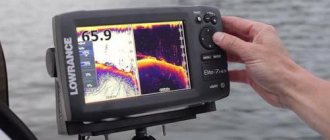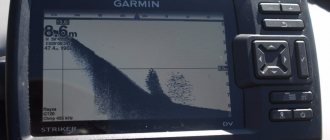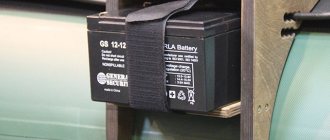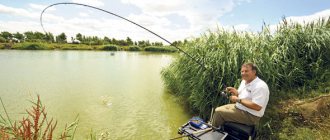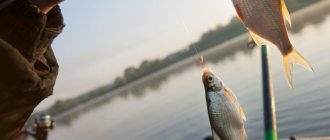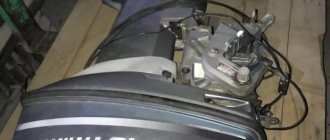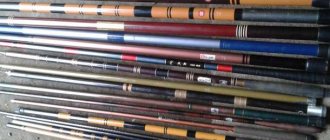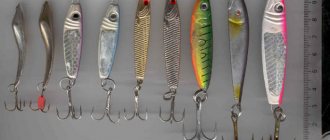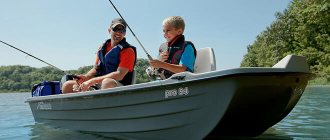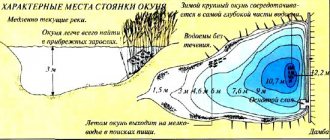How to set up a lowrance hook2 4x fish finder
This part will touch on the most difficult issues related to echo sounders, and for an easier understanding of what is written, I dare to recommend taking the path “from practice to theory”, and not vice versa, as in the classics.
I mean, it's much better if you already have some practical experience using a fish finder. That is, spend a few fishing trips with an echo sounder, and then read the article, which, hopefully, will explain why all these settings are needed and how everything works. After this, you can consciously play with the settings or leave everything as it is with peace of mind. Therefore, it is better to turn on the echo sounder, ride around and see what it shows. In principle, “from the factory” the settings are already set quite optimally so that it shows a good picture. We just turn it on, drive, watch, and turn it off after fishing. But you can, of course, read the article, take a ride and read it again - of course it will be even better. Just if something is not clear, skip it, you’ll figure it out over time. The purpose of the article is to reduce this time. So, let's begin.
Frequencies and rays
200 kHz
The most common frequency for 2D echo sounders. Works up to approximately 300 meters, creates a beam width of up to 60 degrees (provided the sensitivity level is set to high) and the cleanest and clearest picture.
Here is a diagram of a 50 kHz beam, but the principle is the same when switching to other beams - 200 and 83 kHz, just the angles in degrees will change depending on what frequency and sensitivity we have selected in the menu.
Those. this beam itself is narrow for a clearer depiction of the bottom, but when we increase the sensitivity parameter, it expands and, accordingly, captures more underwater objects, such as fish.
What is it for? It is clear that a wide beam is good for finding fish, but good should also be in moderation. If the beam is too wide, it will collect everything around the boat. A mess of a mass of arcs or fish will appear on the screen, but it will be very difficult to understand where it all is or was. But that is not all. There is one more nuance - if the device scans the bottom with a wide beam, then serious inaccuracies will begin between the readings on the screen and the real bottom topography. Especially when passing along the coastal dump.
For example, if the shore and the drop off from it are, say, on the starboard side, then the right edge of our excessively wide beam will “fall” on the upper edge of the edge, and the left edge will fall down from the edge. In this case, colossal, sharp changes in depth will be drawn on the screen, which in reality do not exist. We simply walk along the coastal dump as in the upper diagram with rays. At the top of the drop there will be, let’s say, 2-3 meters, and at the bottom, let’s say, 7-8 and the echo sounder processor will be “confused in the readings”, should we show 2 or 5 or 8 meters. That's why Lowrance made such a smart beam.
So a narrow beam is more likely to be good if the precise bottom topography is primarily important. Here's another analogy to make it easier to understand why. Imagine that you need to draw some kind of landscape. For this you have a wide, construction brush and a thin pencil. What will be better, clearer and more accurate to draw? Again, I repeat - this is especially true when passing along a sharp coastal edge, when one side of the beam touches its upper part, and the other “falls” down. But it is worth noting that the new frequencies of 455 and 800 kHz and, accordingly, the beams are already arranged according to different principles and, with a significant width, the accuracy of the image of the bottom and bottom structures is simply amazing. But more on that below.
If your echo sounder has a choice between 200, 83 and 50 frequencies, 200 kHz will be the main frequency in the vast majority of cases on your fishing trips. The remaining two will only be auxiliary for special conditions, which will be discussed below. It’s also worth immediately warning that the three mentioned frequencies cannot work simultaneously in the echo sounder. Even if all three are on the menu, only two will work at a time. In this case, when both are turned on, the echo sounder itself will divide the screen into two windows. In one there will be a picture with one frequency, in the other with another. Which frequencies will work for you depends on the sensor and the echo sounder menu settings. A “marine” sensor can create 200 and 50 frequencies, a regular sensor 200 and 83 frequencies. That is, everything depends on the sensor, and not on the “head”.
50 kHz
The so-called “marine” frequency. Designed for powerful penetration of sea water. Creates a beam of about 90 degrees, which is capable of imaging the bottom at depths of up to 1500 meters. Why is its beam wider than the previous frequency? Logically, this was done to counteract the confusing properties of pitching. In practice, when this frequency is turned on, the “clicks” from the sensor become rare, but strong. Thus, this beam penetrates deeper into salty, denser water.
But I think you are unlikely to need this frequency even for sea fishing at depths of up to 100 meters. It is wider than the classic 200 kHz for a reason. In this case, the beam width will smooth out the distortion of the real depth as a result of pitching. That is, a wider beam will better image the bottom when the ship is pitching at sea. When to turn it on? Then, when the 200 frequency can no longer cope. Does not reach the bottom, and therefore does not display the bottom, due to excessive depth, pitching or speed of movement.
83 kHz
A relatively new frequency, designed for use in shallow waters. Shallow water, in my understanding, is 6m or shallower. When it is turned on, the beam width increases to 120 degrees (when the sensitivity is set to maximum). Accordingly, the bottom capture becomes twice as large compared to a 200 kHz beam. On the one hand, it’s good - there is more coverage of the bottom, on the other hand, the accuracy of drawing the bottom decreases, especially when passing along the coastal slope, when one side of the beam touches the upper edge of the edge, and the other the lower. Therefore, it is better not to abuse the inclusion of this frequency unnecessarily. It makes sense to turn it on in frankly small places - less than 4 meters. Although this is unlikely to increase the chances of seeing a fish standing to the side. Most likely, it will swim away from under the boat before it enters the beam's range of action. It’s a different matter when we plumb-catch catfish using quok or horse mackerel in the sea. A beam that is twice as wide is more likely to see tackle or fish missing from the thinner cone of the 200 kHz beam. And here it makes complete sense to try to use it.
If you really need such a beam in addition to the base 200 kHz, look for a model with the inscription Pro at the end of the name of entry-level models. Or check if it is available on advanced models without the Pro inscription. For example, in the Lowrance HDS and Elite series.
For the new generation of echo sounders DSI, HDI and LSS, two new frequencies have been introduced - 455 and 800 kHz .
455 kHz
800 kHz
It somewhat shortens the length of the side rays and begins to “get lost” at a depth of more than 18 meters with a significantly silted bottom. On the other hand, when searching quickly at full speed (of course, not at significant depths), I would prefer to turn it on. Because, with such a pulse sending frequency that is significantly higher than the rest, the picture has a chance to be depicted in more detail than at 455 frequency , not to mention the classic 200, 50, 83 kHz . In practice, it turns out that 455 kHz is still used much more often, and it makes sense to turn on 800 only either at depths of less than 6 meters or for fine drawing of the Downscanner (lower high-frequency beam), and then to a depth of 15 meters.
Now, more about the possibilities of the new frequencies (455-800) . Not only is the frequency two to four times higher than the classic, familiar 200 kHz frequency, but also the beam operating at this frequency has a different shape, flat, in the form of a lemon slice in cross-section. That is, if you look at the “spot” from the beam from above, it will be a strongly flattened ellipse, perpendicular to the movement, and not a circle from a cone, like from the light of a flashlight in a classic 2D echo sounder.
Basic features of the echo sounder
The Lowrance Hook 4 device organizes fishing as efficiently as possible. In addition to manual settings, it has a fully automatic mode. You can go fishing or control the movement of the vessel and at the same time look at the screen. At this time, the “Auto settings” function will change the echo sounder settings to suit changing conditions. When approaching shallows, the device beeps.
Another useful new feature is the TrackBack mode. The name speaks for itself: you have the opportunity to view echograms, including structure, transitions, fish targets, and mark them with waypoints.
Information coming from two sonars can be viewed on different screens. Professionals believe that this makes it more convenient to analyze data.
Also, Lowrance Hook 4 (Lawrence Hook 4) supports Navionics and C-Map navigation depth maps. If you have a MicroSD connector, you will be able to save recordings in the device’s memory and even draw depth maps yourself and analyze the routes taken. The device has a vertical display, so it is not always convenient for the fisherman to read the information.
In practice everything is simpler
I should make you happy. On the water, everything will be much simpler than it is written in the article or, if you explain it in words “on your fingers”, or show it in demo mode. Many seemingly difficult questions will disappear by themselves as soon as you turn it on and start moving along the pond. Further, it is worth noting that training, as I already said, is even better to carry out not from theory to practice, as recommended by the classics of the theory of teaching methods, but vice versa. That is, at first we take it and “blindly” test it, guided more by intuition than by knowledge. Then we have specific questions, and then we look for answers to them in sources or when talking with experts. Again practice, again questions and again looking for answers. Therefore, it is even better if you have already practiced with an echo sounder for some time and now understand it by reading this article.
If something is not clear, don’t be particularly upset, I assure you, over time, after some practice, it will be simply simple and understandable. Just skip with your eyes as you read further, and re-read the same after about 10-15 fishing trips.
But first, it’s worth understanding the basics.
The principle of operation of an echo sounder - as briefly as possible
An important question, I recommend that you strain and delve into it. This will help you understand his images more successfully in the future. Moreover, everything is very simple: like two and two.
So, the emitter sensor sends sound clicks (pulses) towards the bottom.
The pulse encounters various objects along its path and finally reaches the bottom and is reflected back up to the emitter sensor, which now receives it back. On the way to the bottom and back, the impulse collected various information: the number, size and density of objects in the water column and, finally, the bottom itself. The head, or rather its processor, processes the information it collects and displays it on the display in the form of a moving, graphic image. Something like a cardiogram of the heart.
And here one very important point should be taken into account: regardless of the speed of your watercraft, from a complete stop to maximum speed, the echo sounder screen will scroll the image at the same programmed speed. And the user has a fair question: “We are standing still, but the picture is moving! How is that possible? Moreover, if there is a fish or tackle under the boat in the cone of the beam, then a long strip will appear on the screen, and a novice user will get the impression that it is something huge. In fact, the impulse bounces off the same object repeatedly, and the screen is forced to show it constantly.
Now let’s assume that we pass over the same object at a speed of 5 km/h and the impulse will be reflected from our object (fish, snag, grass, net) only a few dozen times. And, most likely, a so-called arc or spot of a certain size will appear on the screen. And if we then pass the object at a speed of 20 - 50 km/h, then the beam will only have time to hit the object a couple of times. And he will be depicted as a very small and short arch. Or maybe it won’t have time to be displayed at all if the object is small and the speed is high. Moreover, in all three cases the screen will scroll at the same speed.
Specifications
The Lowrance Elite 4x CHIRP echo sounder, the characteristics of which are given in the accompanying documents for the device, brings this mechanism to the same level as premium ones:
• The number of information rays is 4. This is enough to obtain a reliable picture.
• Display resolution - 480x272 pixels. To obtain an informative picture, this resolution is more than enough.
• The size of the digital information display is 4.3 inches. This size is convenient both for installation on a floating vehicle and for visual perception.
• LED display backlight, saving resources. The advantage of such illumination is maximum safety for human eyes.
• Maximum operating depth of the system:
• 91 meters at 455/800 kHz;
• 229 meters at 83/200 kHz.
• Echolocation signal power - 500 W RMS. This power is enough for accurate and prompt signal transmission.
• Requirement for the electrical power system is 10-17 V DC. Adaptation to such a power supply system is possible through special adapters.
• Operating frequencies - 800, 80, 455 and 200 kHz. Such frequencies are available in many countries.
• Card slot type: microSD. The ability to use an external memory card is useful when systematically fishing in the same area. And using a microSD memory card is a convenient storage device form factor.
• CHIRP system that reduces noise. Thanks to the introduction of this noise reduction system, the information on the display is displayed in the most accurate form.
• Antenna size - 16 channels. This size is sufficient to use the echo sounder in any area.
Such technical characteristics of the echo sounder are sufficient for the effective operation of the device.
How to use an echo sounder?
Almost regardless of model or brand - it's really simple. We turn it on - we ride and watch - we turn it off at the end of fishing.
By and large, they do not need to be used in the usual sense of the word. The word use would be more appropriate. That is, by and large, it does everything itself, just turn it on and don’t forget to turn it off at the end. It’s just how the manufacturer intended it and all the default settings from the factory are set to auto modes, which work quite normally. Unless, perhaps, it’s worth adjusting it for the first time to suit your own or new fishing conditions, and that’s all. Further, you may need some minor correction no more than 1-2 times a year.
If you own an echo sounder-chartplotter, then the “On-Off” rule also works, but it wouldn’t hurt to learn more “advanced” techniques. If we make a comparison, it’s the same as when we bought a TV, connected everything, learned how to turn it on and off, and watched the same program. It is clear that it is advisable to at least learn how to switch channels. This will open up great opportunities! Understanding what it shows is another matter. This will be discussed below.
But still, even with such simplicity, several important, elementary rules must be followed. If the task is to thoroughly and accurately examine the water area for the presence or absence of fish and study the bottom topography, then:
- The speed of the boat must be no less than 4 and no more than 10 km/h. And the best is 5-6 km/h. For ease of visual understanding, this is the speed of a fast human step. Such a seemingly simple task can become complicated under the influence of strong winds or currents. When moving against a significant wind or current, the illusion of sufficient speed will be created due to the good rustling of the water against the sides of the boat. And vice versa, when going with the wind or current, you will want to increase the gas. To correctly solve our problems (high-quality, truthful pictures), the speed of 5-6 km/h should be relative to the bottom, and not the sensations of the water.
In such situations, the speed indicator on the GPS will be very helpful. This is one of the important arguments in favor of purchasing an echo sounder - chartplotter. In a nutshell, the motto is: “don’t trust your eyes and ears - trust the number on the GPS screen!” In the absence of it, we orient ourselves at least relative to the shore. If there is almost no current, then it is better to orient yourself relative to the water surface, imagining a human step. Try to keep the boat on a level course. A common mistake, both professionals and beginners, is “going headlong” into the screen, not noticing the world around you. And as a result, the boat’s uncontrolled course. And a confused understanding of what is under water. This rule is especially relevant when using new generation echo sounders with scanning technology. For those interested, you can watch the video “Questions and answers about LOWRANCE Mark-5x DSI and Elite-5 DSI echo sounders.”
By analogy, correct study of the water area using an echo sounder will be similar to the operation of a combine harvester. Smooth passages in one direction or the other, with steps the width of the beam, without skipping or marking time. If the echo sounder is equipped with GPS, then the correctness of your passages can be tracked on the screen along the remaining track (trace) - another argument in favor of purchasing it. If you don’t have a chartplotter, but just an echo sounder, you can look at the wake. If something appears on the screen, it means that it was left behind the stern a couple of seconds ago (the time of emission and reception of the pulse and its processing is approximately 1.5-3 seconds) and from the trace you can roughly guess where exactly it was. For the latest generation of Lowrance fish finder/chartplotter combinations, you can simply point the cursor directly on the fish finder at the object you found and the built-in GPS will calculate exactly where it was. And it will make it possible to immediately place a waypoint in this place on the “Map” page.
- For newer generation fish finders abbreviated DSI, HDI, or with a StructureScan unit, it is important to avoid diagonal, “oblique” scanning . This is when, under the influence of a strong side wind or current, the boat goes “as if skidding.” That is, the boat's course (course line) does not coincide with the real direction of movement. The boat goes a little sideways, and in this case the picture is slightly distorted. Therefore, the recommendation is simple - in such conditions, scan either against or with the current or wind and as rarely as possible across, exposing the side.
Of course, in order to fully and quickly understand the most modern technology (especially HDS with the additional Structure Scanner block), it is better to hire a specialist who can conduct a training course. In my experience, you can fully learn how to use this technique in three hours. If this is not possible, carefully study the article and try to apply what is stated in practice.
Rating of popular models
The company has a huge number of different models of echo sounders, but not all are in particular demand among domestic fishermen. Most likely, this is due to the specifics of production and certain purposes, since some products are presented exclusively at a professional level, and some are even intended for sea fishing.
Lowrance Elite-3x
This easy-to-use and intuitive device helps to detect the location of underwater inhabitants, examine the topography of the bottom surface, and determine its structure. The picture is displayed on a display with a resolution of 320x240 pixels, supporting 256 colors. In addition, additional data is provided: temperature, battery charge level and other useful information.
The built-in ASP system independently adjusts the sharpness and details of the scanned space, relieving the fisherman of the need to perform these manipulations manually. Many people purchase this device because of the Fish ID technology, which processes the echogram using a complex algorithm. Thanks to this function, fish are classified by size and displayed on the screen with special symbols, and their detection is accompanied by an audible signal.
What else can Elite-3x boast? Quite a sensitive transducer. This sensor operates at two frequencies (83 and 200 kHz), that is, it scans a location using two beams with different viewing angles. Compared to other characteristics, their “range” is impressive. The manufacturer stated a maximum depth of almost 250 meters, which is more than enough for fishing.
Unfortunately, the Elite-3x color fish finder from Lowrance is not without serious drawbacks. Firstly, there are no numbers for determining the depth, which sometimes confuses not only beginners, but also experienced fisherman. Instead, 3 lines appear on the screen, so the depth has to be calculated in your head.
The second problem occurs at depths greater than 30 meters if the device operates in automatic mode. It consists in the fact that the bottom image is stretched to half the screen. The only way to fix it is to switch to manual mode and set the actual depth as the maximum.
Lowrance Hook-3x
The Hook model range has been produced by Lowrance since 2015. Hook 3 devices are basic models, the capabilities of which are limited only to basic functions - scanning the bottom of a reservoir and searching for fish.
They have the smallest dimensions and display sizes. They do not have any special options, such as the presence of a chartplotter or GPS receiver. Nevertheless, these models are very popular among fishermen, because, given their low cost, they work much better and more reliably than their Chinese “analogues”.
The models under consideration are high-performance broadband echo sounders equipped with a target separation and noise reduction system, which greatly simplifies the search for prey. They are very simple and easy to use and can be used on almost all types of reservoirs.
The Hook 3x fish finder is a classic dual-beam fish finder with transducer frequencies of 83 KHz and 200 KHz. The sensor coverage area when using these frequencies is a cone with angles of 60° and 20°, respectively. A lower frequency is used to survey large surfaces and search for concentrations of fish, a higher frequency is used for improved and more accurate determination of their position.
The water depth and temperature are displayed in the upper left corner. The relief and nature of the bottom are displayed in the appropriate color, the images of fish are represented by arcs. The water surface level is considered to be the topmost line of the display. It is indicated by the number "0".
The maximum scanning depth of the Hook 3x is 244 m, while the echo sounder is capable of operating at boat speeds of up to 112 km/h. The radiation power of its transducer is 100 W.
In addition, the Lawrence Hook 3x echo sounder has a FishID mode, which allows you to display fish in the form of an icon indicating the depth at which it is located. The device has a mode for simultaneous display of two operating modes: the classic image of the echo sounder and FishID. The screen is divided into two windows.
Lowrance Elite-3x DSI
The Hook 3x DSI fish finder works on a different principle. It is also equipped with a dual-beam transducer, but its operating frequencies are significantly higher. They are 455 KHz and 800 KHz. The use of such high frequencies is due to the use of so-called technology in this model. bottom scan or DownScan.
In this mode of operation, the beam coverage area is not a classic cone with a round base, but only a small part of it, directed perpendicular to the movement of the boat. This does not make it possible to search for fish when fishing is carried out from a stationary craft, however, when fishing in motion, the image obtained using such a device is much clearer and more informative.
When using this technology, fish are displayed not in the form of arcs, but in the form of separate objects. Schools of small fish will be displayed as a cloud, large fish can be seen as a separate spot, and if the fish is large enough, its individual parts (for example, the tail or head) can be distinguished.
Thus, using the Hook 3x DSI echo sounder allows you to obtain better information about what is happening in the depths of the reservoir. However, everything comes at a price. Obtaining a beautiful picture imposes certain restrictions on the use of this model:
- A much smaller volume of water is scanned compared to the “classic”, which requires constant movement of the craft along the surface of the reservoir.
- The scanning depth of the Hook 3x DSI echo sounder model is slightly less than that of the Hook 3x and is 91 m, although this is not critical for fishing in fresh water bodies.
- The transmitter power of the Hook 3x DSI echo sounder is five times higher than the “classic” (i.e. 500 W), which reduces its continuous battery life.
Lowrance Hook-4x Mid (High) Down Scan
This is a fish finder/chartplotter with built-in GPS. The device is capable of remembering routes, promising points and other similar places, making it possible to return to exactly the same place next time.
Among other features of the echo sounder it is worth noting:
- Advanced Signal Processing technology, the essence of which is automatic adjustment of sensor settings. It provides the most suitable modes of operation of the sensor in specific conditions without intervention by the fisherman.
- The device has a built-in temperature sensor and can also emit sound signals when a fish is detected or when the craft reaches a predetermined depth.
- The menu is completely Russified, which allows you to quickly configure 4x mid high downscan.
- Like most similar devices, there is a Fish ID function, which displays information about detected fish on the screen in the form of corresponding icons.
- The echo sounder has a slot for connecting memory cards, which allows you to record and store a large amount of map data with specified catch points or discovered promising fishing spots.
Lowrance Elite-7 TI
The Lowrance Elite 7 Ti echo sounder is a multifunctional device with which you can not only scan the bottom, but create depth maps. This model is a full-fledged chartplotter.
For full operation of the device, you can use a 7.5 Mah battery. The main advantage of the Lowrance Elite 7 Ti echo sounder is the presence of a structure scanner. With this sensor you can scan the bottom on the left and right side of the boat.
The touch display has a diagonal size of 7 inches and a resolution of 800x480. The picture turns out to be of very high quality. You can see the smallest details at the bottom. The device is controlled using side buttons and a touch screen. A light touch of your fingers is enough to switch the menu and select the necessary modes.
The echo sounder is capable of operating in four frequency modes: 83, 20, 455, 880 KHz. When scanning at a speed of 40-50 km/h, the data on the screen is displayed with the same accuracy as at the minimum speed.
Lowrance Hook-5x
The Lowrance HOOK-5x Mid/High/DownScan echo sounder (Lawrence HOOK 5 X) is designed for scanning the bottom topography and recording fish concentrations. The display is installed on the side of the boat, and the sensor is immersed in the water. The following accessories are included with this model:
- Quick release mount.
- Sensor HDI Skimmer XDCR 83/200+455/800 kHz (cable length 6 m).
- Transom sensor mounting bracket.
- Fasteners
- Power cable.
- Fuse (3 A).
The sensor is equipped with a 500 W irradiator. The maximum coverage depth is 90 meters. The image is displayed on a 13 cm wide monitor in color with a resolution of 480x480 pixels. For control, there are buttons on the left side of the display. In demo mode you can see how the device works.
Lowrance HDS-7 Gen 3 50/200
Lowrance HDS-7 Gen3 50/200 echo sounder - a design-led new Lowrance High Definition System in the HDS Gen3 series echo sounders combines advanced sonar technologies and the latest developments in navigation, which are integrated into one easy-to-use multi-touch display.
The all-new HDS system combines a brighter multi-touch display and improved sonar processor with advanced technologies including CHIRP Sonar, Broadband Sounder™, StructureScan® HD, DownScan Imaging™ and Trackback™, as well as other technology innovations in navigation and user experience. interfaces, such as a built-in 10Hz GPS antenna, a double slot for MicroSD cards, touch-button display control, and a built-in Wi-Fi module. And all this in one easy-to-use display.
Lowrance Mark-5x Pro
This model features an updated, improved menu and a very quick and fairly simple attachment, which makes it very easy to use while fishing. In addition, the new monitor is equipped with an adjustable backlight, which makes it possible to use it in almost any lighting conditions. The monitor size of five inches allows for comfortable reading of information under any environmental conditions.
One of the promising new features of the Mark-5x is a function that allows you to rewind and replay multiple pages of the device's image history. Using this innovation, the fisherman will never swim past a fishing spot.
Taking into account the needs and wishes of users, Lowrance developers have introduced an improved menu in the new model, which can be controlled with one finger. Like all Lowrance devices, Mark-5x echo sounders have an absolutely sealed electrical part, which allows the echo sounder to be immersed in water to a depth of one meter, where the device can remain for almost thirty minutes without loss of functionality. This circumstance is especially important in conditions of winter fishing or fishing from a boat. Not every echo sounder can boast such indicators.
Lowrance Elite-3-x HD 83/200 000-11448-001
This device has a 3.5-inch display, 2-frequency sensor (83/200 kHz, 180 Watts, with tracking to a depth of up to 244 m. The device has the latest Lowrance Broadband Sounder technology, which allows fishermen to easily and quickly determine the location of fish and inspect bottom relief. Users can switch the image view up to 4x magnification. Control in Russian.
How to understand it?
Everything is clear - this is a curved line at the bottom of the screen, its bends convey the corresponding relief. Is it possible to judge the density of the soil by the color of the bottom line? Yes, but very rude. That is, you probably won’t be able to notice a subtle difference in density from silt to shell. At least I can't. But a significant change can perhaps be identified. For example, a river bed (clean sand) is a relatively thin strip of bottom. We enter a silted bay and the bottom strip becomes much fatter. But there must be a very significant difference in soil density to notice it.
There is one important feature. There are places where the amount of silt is simply prohibitive and it is very liquid, like semolina porridge. This happens most often where there is a lot of water chestnut (chalima). There, the echo sounder signal may simply disappear, and this does not depend on the brand, type of echo sounder or sensor. There is simply nothing for the signal to reflect from and it simply “goes out” in the deep liquid silt.
What else should you consider? As I already said, the delay in the signal passing from the sensor to the bottom and back to the sensor is approximately 1-2 seconds. That is, the depth figure is what was behind you 1-2 seconds ago. It should be taken into account that at the moment the depth figure is displayed on the screen, the boat may already be driving at full throttle 10-20 meters from the place where the readings were taken. On Lawrence's latest models, combined with GPS and echo sounder, you can easily calculate the location of an object floating across the screen. Simply by pointing the cursor at an object of interest on the echo sounder screen, the carplotter, in turn, will accurately calculate its location and allow you to place a point on the map screen, even if you have gone a considerable distance from this place.
On a classic echo sounder, fish are displayed in the form of a so-called arc.
On new echo sounders with scanning technology - in the form of a blot or dot (depending on the size of the fish) of different shapes.
Above were two screenshots of the echo sounder screen simultaneously depicting the same fish with different beams. All of the above-mentioned echo sounders are capable of displaying fish the size of a little finger on the screen.
More frequently asked questions:
Does a fish finder scare fish?
I guess it all depends on the specific case. What kind of fish, at what depth, active - passive, in snags or on the open bottom, on what boat is the fisherman, in what geographical location, that is, is the fish familiar with humans? That is, somewhere in the north, on a wild reservoir, most likely the pulses of the echo sounder will even attract fish with their novelty. And at the same time, the same fish in similar conditions, but in a densely populated fishing area, may be very wary of the sound that it associates with the recent dangerous ups and downs. There is also a mode for recognizing fish and displaying it with fish symbols - for life. Moreover, fish are able to warn each other about danger associated, for example, with some object (I personally saw it).
I once asked a question to one experienced “quack fisherman”: does the echo sounder scare the catfish when it rises to the quok? To which he answered me - “I don’t care whether it’s scary or not, just watching his approach on the screen is such an exciting and exciting sight that even the thought of turning it off doesn’t even occur to me.”
And yet, listening to different stories and comparing my experiences, I’ll say that it’s most likely not scary and there’s really no point in turning it off, unless it’s to save the battery.
What happens if you “shine” the sensor away from the boat. Is it possible to “spot” fish?
Nothing will happen. The echo sounder will simply stop perceiving the space in which it operates; the impulse will have nothing to reflect, since the bottom will disappear. That is, a classic boat echo sounder is definitely not suitable for these purposes. Although attempts are constantly being made. There are models of echo sounders for side viewing, both quite budget-friendly and professional for sea trawl fishing. But I have never heard good reviews about budget ones, and industrial ones are unreasonably expensive and are suitable for use specifically in the sea for trawls.
For preparing the material, we would like to express our gratitude to Yuri Orlov, a specialist in the installation and configuration of marine navigation equipment
Source
